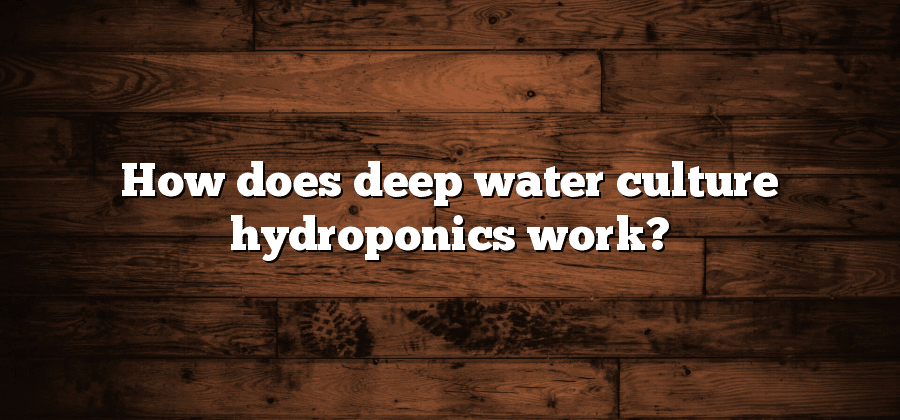The Basics of Deep Water Culture Hydroponics
Deep Water Culture (DWC) hydroponics is a popular system among hydroponic enthusiasts due to its simplicity and effectiveness. This method involves suspending plant roots in a nutrient-rich solution, allowing them to absorb essential elements directly. By eliminating the need for soil and traditional hydroponic substrates, DWC offers a clean and efficient way to cultivate plants.
One of the key advantages of DWC is its ability to provide a consistent and easily adjusted nutrient solution. This solution is crucial for the plants’ growth and development, as it supplies all the necessary minerals and trace elements. By closely monitoring and adjusting the nutrient solution, hydroponic gardeners can optimize plant uptake and promote healthy growth. Getting the right balance of nutrients is essential to ensure plants receive the proper amounts of macronutrients (such as nitrogen, phosphorus, and potassium) and micronutrients (such as iron, zinc, and manganese).
Understanding the Role of Nutrient Solution in Deep Water Culture
The nutrient solution plays a crucial role in deep water culture hydroponics, providing all the essential elements that plants need for growth and development. This solution replaces the traditional soil medium by supplying a balanced mixture of nutrients directly to the plants’ root systems in a water-based environment.
The nutrient solution consists of various essential macronutrients, including nitrogen, phosphorus, and potassium, as well as micronutrients such as iron, manganese, and zinc. These nutrients are dissolved in water and carefully monitored to ensure that the plants receive the correct amount of each element. This precise control over nutrient levels allows for optimal plant growth and helps prevent nutrient deficiencies or toxicities. A well-balanced nutrient solution is crucial for healthy plants, strong root development, and improved yield in deep water culture hydroponic systems.
Key Components: Reservoir, Air Pump, and Air Stone
The components that make up a deep water culture hydroponic system are key to its successful operation. Among these, the reservoir, air pump, and air stone play vital roles in supporting the healthy growth of plants.
The reservoir serves as the heart of the system, containing the nutrient solution that nourishes the plants’ roots. It should be made of a non-transparent material to prevent the growth of algae, which can compete with the plants for nutrients. The size of the reservoir should be determined based on the number of plants being grown and their specific water requirements. It is crucial to regularly monitor and maintain the nutrient solution levels in the reservoir to ensure that the plants are receiving the necessary amount of nutrients for optimal growth.
The air pump and air stone work together to provide essential oxygenation within the system. The air pump is responsible for creating airflow, which is then directed through the air stone and into the nutrient solution. This infusion of oxygen is crucial for the plants’ root development, as it helps prevent root rot and promotes overall plant health. The air pump should be selected based on the size of the system and the number of air stones being used, ensuring that enough oxygen is supplied to all plant roots. Proper maintenance of these components, including regular cleaning and replacement of worn-out parts, is vital to maintain a healthy and thriving deep water culture system.
The Vital Importance of Oxygenation in Deep Water Culture
Deep Water Culture (DWC) hydroponics is a popular method for growing plants without soil. One key aspect that sets DWC apart from other hydroponic systems is the vital importance of oxygenation. In DWC, plants are suspended in nutrient-rich water, and ensuring a consistent supply of oxygen to the roots is crucial for their overall health and growth.
Oxygenation in deep water culture serves several critical functions. First and foremost, it provides oxygen directly to the roots, allowing them to perform essential functions such as respiration and nutrient absorption. Without adequate oxygenation, the roots may become suffocated, leading to root rot and poor plant development. Additionally, oxygenation promotes the growth of beneficial bacteria in the nutrient solution, which play a vital role in breaking down organic matter and making essential nutrients more accessible to the plants. Overall, maintaining optimal oxygen levels in the water is essential for creating an environment that promotes healthy root growth and robust plant development in deep water culture.
Planting in Deep Water Culture: Selecting the Right Medium
Deep water culture (DWC) hydroponics is a popular method of growing plants without soil. It involves suspending the plant’s roots in a nutrient-rich water solution that is continuously aerated. However, in order for the plants to thrive in a DWC system, selecting the right medium is crucial.
When it comes to choosing a medium for DWC, there are several options to consider. One common choice is hydroton, which are clay pellets that provide excellent support for the plants while allowing for good aeration and water retention. Another option is Rockwool cubes, which are made from spun volcanic rock fibers and offer great water absorption and retention properties. Additionally, some growers prefer to use perlite or coco coir as a medium for their DWC systems. The key is to choose a medium that can effectively support the plant’s roots while providing adequate aeration and water retention.






